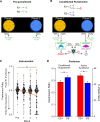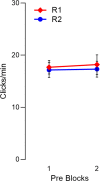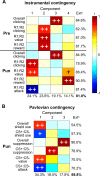Punishment insensitivity in humans is due to failures in instrumental contingency learning
- PMID: 34085930
- PMCID: PMC8177883
- DOI: 10.7554/eLife.69594
Punishment insensitivity in humans is due to failures in instrumental contingency learning
Abstract
Punishment maximises the probability of our individual survival by reducing behaviours that cause us harm, and also sustains trust and fairness in groups essential for social cohesion. However, some individuals are more sensitive to punishment than others and these differences in punishment sensitivity have been linked to a variety of decision-making deficits and psychopathologies. The mechanisms for why individuals differ in punishment sensitivity are poorly understood, although recent studies of conditioned punishment in rodents highlight a key role for punishment contingency detection (Jean-Richard-Dit-Bressel et al., 2019). Here, we applied a novel 'Planets and Pirates' conditioned punishment task in humans, allowing us to identify the mechanisms for why individuals differ in their sensitivity to punishment. We show that punishment sensitivity is bimodally distributed in a large sample of normal participants. Sensitive and insensitive individuals equally liked reward and showed similar rates of reward-seeking. They also equally disliked punishment and did not differ in their valuation of cues that signalled punishment. However, sensitive and insensitive individuals differed profoundly in their capacity to detect and learn volitional control over aversive outcomes. Punishment insensitive individuals did not learn the instrumental contingencies, so they could not withhold behaviour that caused punishment and could not generate appropriately selective behaviours to prevent impending punishment. These differences in punishment sensitivity could not be explained by individual differences in behavioural inhibition, impulsivity, or anxiety. This bimodal punishment sensitivity and these deficits in instrumental contingency learning are identical to those dictating punishment sensitivity in non-human animals, suggesting that they are general properties of aversive learning and decision-making.
Keywords: Instrumental; Punishment; human; learning; neuroscience.
© 2021, Jean-Richard-dit-Bressel et al.
Conflict of interest statement
PJ, JL, SL, GW, PL, GM No competing interests declared
Figures







Similar articles
-
Translational research in punishment learning.Behav Neurosci. 2024 Jun;138(3):143-151. doi: 10.1037/bne0000587. Epub 2024 Apr 18. Behav Neurosci. 2024. PMID: 38635180 Review.
-
Punishment insensitivity emerges from impaired contingency detection, not aversion insensitivity or reward dominance.Elife. 2019 Nov 26;8:e52765. doi: 10.7554/eLife.52765. Elife. 2019. PMID: 31769756 Free PMC article.
-
Nonmonetary Decision-Making Indices Discriminate Between Different Behavioral Components of Gambling.J Gambl Stud. 2015 Dec;31(4):1545-60. doi: 10.1007/s10899-014-9482-1. J Gambl Stud. 2015. PMID: 24986779
-
Impaired Punishment Learning in Conduct Disorder.J Am Acad Child Adolesc Psychiatry. 2024 Apr;63(4):454-463. doi: 10.1016/j.jaac.2023.05.032. Epub 2023 Jul 4. J Am Acad Child Adolesc Psychiatry. 2024. PMID: 37414274
-
Acute stress differentially alters reward-related decision making and inhibitory control under threat of punishment.Neurobiol Stress. 2024 Apr 5;30:100633. doi: 10.1016/j.ynstr.2024.100633. eCollection 2024 May. Neurobiol Stress. 2024. PMID: 38623397 Free PMC article. Review.
Cited by
-
Learning of probabilistic punishment as a model of anxiety produces changes in action but not punisher encoding in the dmPFC and VTA.Elife. 2022 Sep 14;11:e78912. doi: 10.7554/eLife.78912. Elife. 2022. PMID: 36102386 Free PMC article.
-
Causal inference and cognitive-behavioral integration deficits drive stable variation in human punishment sensitivity.Commun Psychol. 2025 Jul 9;3(1):103. doi: 10.1038/s44271-025-00284-9. Commun Psychol. 2025. PMID: 40634489 Free PMC article.
-
Reply to Jarvis and Chong: Understanding punishment insensitivity phenotypes using computational modelling.Proc Natl Acad Sci U S A. 2023 Nov 7;120(45):e2316107120. doi: 10.1073/pnas.2316107120. Epub 2023 Oct 31. Proc Natl Acad Sci U S A. 2023. PMID: 37906641 Free PMC article. No abstract available.
-
Approach-avoidance reinforcement learning as a translational and computational model of anxiety-related avoidance.Elife. 2023 Nov 14;12:RP87720. doi: 10.7554/eLife.87720. Elife. 2023. PMID: 37963085 Free PMC article.
-
Linking drug and food addiction via compulsive appetite.Br J Pharmacol. 2022 Jun;179(11):2589-2609. doi: 10.1111/bph.15797. Epub 2022 Mar 7. Br J Pharmacol. 2022. PMID: 35023154 Free PMC article.
References
-
- American Psychiatric Association . Diagnostic and Statistical Manual of Mental Disorders. 5th edn. Washington, D.C.: American Psychiatric Publishing; 2013.
-
- Blair KS, Morton J, Leonard A, Blair RJR. Impaired decision-making on the basis of both reward and punishment information in individuals with psychopathy. Personality and Individual Differences. 2006;41:155–165. doi: 10.1016/j.paid.2005.11.031. - DOI
Publication types
MeSH terms
LinkOut - more resources
Full Text Sources

